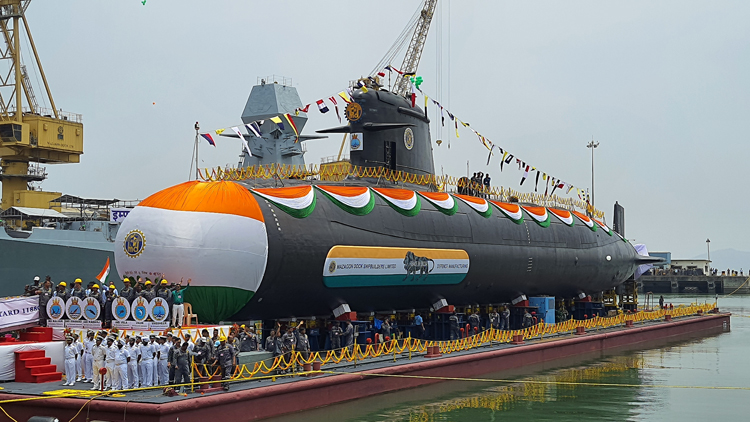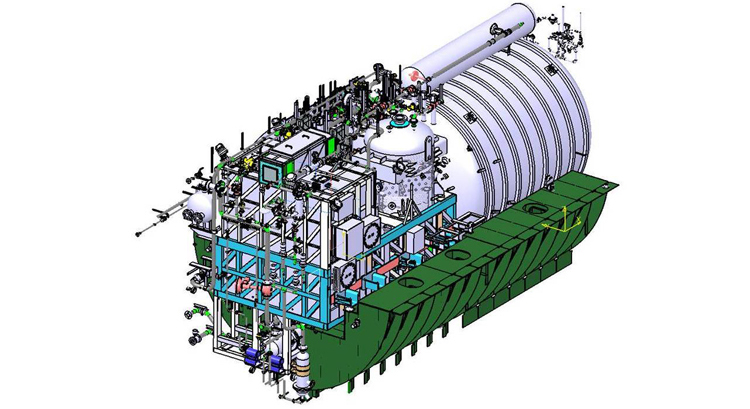INDIAN ARMED FORCES CHIEFS ON OUR RELENTLESS AND FOCUSED PUBLISHING EFFORTS

The insightful articles, inspiring narrations and analytical perspectives presented by the Editorial Team, establish an alluring connect with the reader. My compliments and best wishes to SP Guide Publications.

"Over the past 60 years, the growth of SP Guide Publications has mirrored the rising stature of Indian Navy. Its well-researched and informative magazines on Defence and Aerospace sector have served to shape an educated opinion of our military personnel, policy makers and the public alike. I wish SP's Publication team continued success, fair winds and following seas in all future endeavour!"

Since, its inception in 1964, SP Guide Publications has consistently demonstrated commitment to high-quality journalism in the aerospace and defence sectors, earning a well-deserved reputation as Asia's largest media house in this domain. I wish SP Guide Publications continued success in its pursuit of excellence.
- MoD initiates comprehensive review of Defence Acquisition Procedure 2020, pushes for defence reforms
- G7: The Swansong
- Kalinga Connect: South Asia to Polynesia
- Advanced MRSAM for India for a greater firepower
- Must Credit DRDO for Operation Sindoor, now what is next for defence R&D?
- Operation Sindoor | Day 2 DGMOs Briefing
- Operation Sindoor: Resolute yet Restrained
UUVs and Project-76 Submarines
The Indian Navy is preparing for future warfare by upgrading its unmanned underwater capabilities and building six next-generation diesel-electric attack submarines Project-76 (P-76)
 |
The Author is Former Director General of Information Systems and A Special Forces Veteran, Indian Army |

According to media reports of September 11, 2024, the Ministry of Defence (MoD) has approved a ₹2,500 crore plan to build 100-tonne unmanned underwater vessels (UUVs) to enhance the Navy's capabilities in underwater operations, including mine laying, surveillance, and launching weapons. A tender for this is to be issued subsequently.
The Ministry of Defence (MoD) has approved a ₹2,500 crore plan to build 100-tonne unmanned underwater vessels (UUVs) to enhance the Navy's capabilities in mine laying, surveillance, and launching weapons.
This is a timely move, considering the increasing use of unmanned underwater vessels for surface and sub-surface warfare, The proposal reportedly is for underwater vessels in the "extra-large" category weighing over 100 tonnes, which would be equipped with strike capabilities against enemy submarines and surface vessels, These UUVs would give the Indian Navy niche capabilities, enabling multiple operations. The Navy has plans of using such vessels for a plethora of tasks such as laying mines and mine clearing operations, surveillance, and launching weapons.
The Indian Navy has been working towards preparing itself for warfare of the future by upgrading its capabilities in the unmanned domain. It is focused on increasing its unmanned long range surveillance capabilities with the induction of drones like the MQ-9B and Drishti Hermes 900 UAVs, and has also been working on unmanned surface vessels (as being used in the ongoing conflicts across the globe) for destroying larger vessels and assets.

As to the UUVs under the ₹2,500 crore plan, the Navy is looking for vessels with capability to remain underwater for very long hours at long distances from the shore to keep an eye on the movement of suspicious vessels and other activities and safeguard national interests. The Navy would be issuing a tender for the project under the Make-1 procedure in the next few months, enabling Indian shipyards to bid for the project under the Atmanirbharta initiative.
India has undertaken ambitious submarine acquisition and development programmes aimed at modernising the Indian Navy's underwater fleet, enhance its strategic capabilities, and promote indigenous defence production. While progressing on Project-75, Project-75I and the nuclear-powered ballistic missile submarine (SSBN) programme, the Indian Navy has simultaneously initiated preliminary studies for the design and development of an indigenous conventional submarine under Project-76.
The Scorpene submarines under Project-75 are being fitted with DRDO's Air Independent Propulsion (AIP) system, enhancing their submerged endurance, with integration starting on the INS Kalvari in 2026.
Project-76 (P-76) aims to boost self-reliance in submarine technology. This initiative plans to develop and deliver six next-generation diesel-electric attack submarines for the Indian Navy. The initiative is a collaborative effort between the Defence Research and Development Organisation (DRDO) and the Navy's Warship Design Bureau. According to reports, the DRDO has begun preliminary studies for the design and development of an indigenous conventional submarine under P-76.
In December 2023, Admiral R. Hari Kumar, then Chief of the Naval Staff, confirmed the existence of an indigenously designed conventional submarine programme known as "P-76" during an interview with the media. This initiative involves building six advanced conventional submarines equipped with Air-Independent Propulsion (AIP) systems. This project is envisioned as a continuation of the Advanced Technology Vessel (ATV) programme, focusing on developing a conventional submarine.

The submarines under Project-76, although still in the early design phase, are to have a displacement of 4,000 tonnes and will feature air-independent propulsion. P-76 aims to use 80 per cent indigenous materials, boosting India's defense industry capabilities. Media reports indicate that the design phase of P-76 is projected to be completed by the end of 2025, with the first prototype expected to be ready by 2030.
Under Project-75, the Indian Navy is receiving six Scorpene-class submarines: INS Kalvari, INS Vela, INS Khanderi, INS Karanj, INS Vagir, and INS Vagsheer. Five of these submarines have been completed, with the sixth nearing completion. These submarines are the result of a collaboration between Mazagon Dock Shipbuilders Limited (MDL) and the French defense firm Naval Group, built on successful technology transfer.
The US has agreed to sell High Altitude Anti-Submarine Warfare (HAASW) sonobuoys worth $52.8 million to India, boosting the Indian Navy's anti-submarine warfare capabilities.
Under Project-75 India (P-75I) an additional six submarines are being constructed with foreign design support building upon the experience gained from P-75 plus incorporating more advanced technologies. A key feature of these submarines will be the incorporation of Air-Independent Propulsion (AIP) systems, significantly enhancing their underwater endurance and stealth capabilities. Project-75I is important because India's submarine fleet is down compared to the fast increasing submarine fleets of China and Pakistan.
Initially, Germany and Spain competed for the ₹43,000-crore Indian Navy submarine project and completed AIP system trials. Mazagon Dock's foreign partner, Germany's Thyssenkrupp Marine Systems (TKMS), successfully demonstrated the Air Independent Propulsion (AIP) capability on its Type 212 submarine, allowing it to remain submerged for up to two weeks. Spain's Navantia, which partnered Larsen & Toubro for Project-75I, couldn't demonstrate a submerged AIP system, only one fitted to a surface-operating submarine. However, the approval for Mazagon Dock to build six submarines with German collaboration is still awaited.

The PLA Navy (PLAN) currently operates a fleet of 66 submarines, which include nuclear as well as conventional submarines. China's recent breakthrough in laser-propulsion could provide a decisive edge to China's growing naval ambitions. This could usher a new era of stealthy submarine warfare. Qianlong III, a Chinese autonomous underwater vehicle (AUV) has a maximum operating depth of around 14,800 feet underwater. This 1.5-tonne, 11-foot-long AUV has dived deep into the South China Sea, undertaking a nearly 160-km, 42-hour voyage.
China's 'Underwater Great Wall' of networked seabed sensors and long endurance UUVs like the Qianlong III and the Haiyan glider are tasked with identifying enemy submarines, mines, and other UUVs. PLAN has plans for swarms on the seas and in the air, and private Chinese firms are pitching multi-hulled robot warships and a 56-USV swarm for militarised purposes.
China's development of laser-propulsion and autonomous underwater vehicles (AUVs) like the Qianlong III is enhancing its naval capabilities, marking significant advances in stealthy submarine warfare.
The Indian Navy's Scorpene submarines are set to be fitted with the DRDO developed Air Independent Propulsion (AIP) system. According to Samir V. Kamat, Chairperson of DRDO, the AIP system will be integrated into the submarines during their refit, starting with the INS Kalvari in 2026. This will enhance the submerged endurance of these diesel-electric submarines, allowing them to operate underwater for extended periods without surfacing.

According to news reports of September 12, 2024, the US has decided to sell High Altitude Anti-Submarine Warfare (HAASW) sonobuoys (AN/SSQ-62F) to India worth $52.8 million. This will enhance the combat capacity of the Indian Navy to conduct anti-submarine warfare operations from its US-supplied MH-60R helicopters. The US Department of Defense (DoD) has notified the US Congress about the sale, which awaits congressional approval. According to the congressional notification, India had sought the purchase of AN/SSQ-530 HAASW sonobuoys, AN/SSQ-62F HAASW sonobuoys and AN/SSQ-36 HAASW sonobuoys. Sonobuoys are air-launched, expendable, electro-mechanical sensors designed to relay underwater sounds to remote processors. These are effective and affordable.
The Indian Navy's UUVs and multiple submarine projects will boost India's naval prowess, extending the Indian Navy's strategic reach and underwater capabilities. These being long-term projects, maintaining the momentum of development is of utmost importance.





